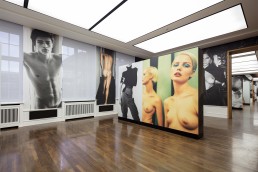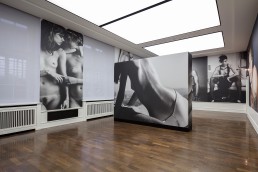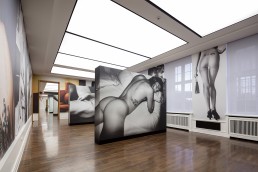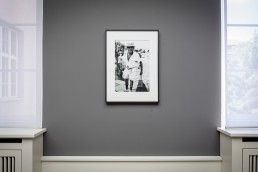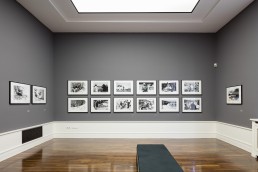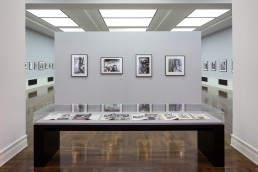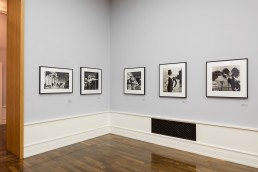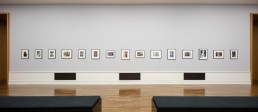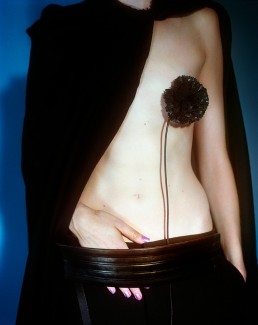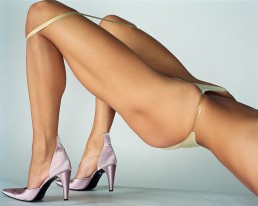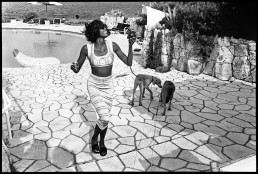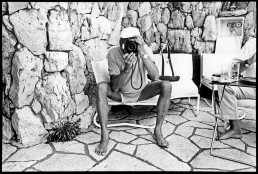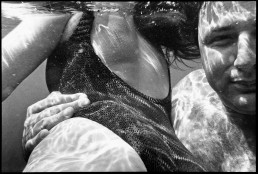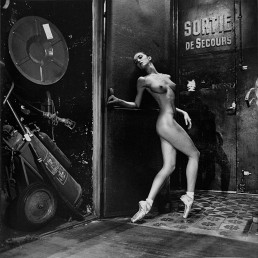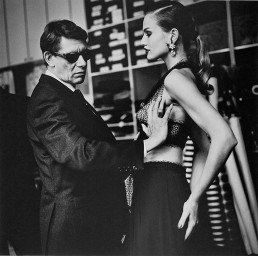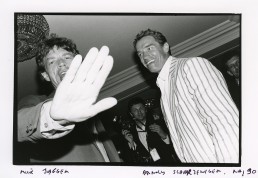Upon establishing his foundation in Berlin in 2003, Helmut Newton expressed his wish to provide a forum not only for his own works, but for that of other photographers as well. His wish continues to be fulfilled posthumously, now with two unique projects by two of Helmut Newton’s friends and colleagues: Mario Testino and Jean Pigozzi.
Mario Testino’s Undressed is a site-specific installation comprising fashion and nude photos. It was conceived exclusively for the Helmut Newton Foundation. The work analyses the boundaries between fashion, eroticism, anatomy and art, as well as a metaphorical undressing of Mario Testino that delves deeper into his archive and his working practice. 50 larger-than-life images are affixed directly to the walls in three of the foundation’s exhibition halls, reaching into the corners of the room and up to the ceiling. This presentation form is unique to both Testino’s work as well as the exhibition history of the Helmut Newton Foundation, filling the rooms with bodies and emotions to create an imposing human landscape.
Helmut Newton is represented by original prints in various formats, selected from the foundation’s archive, they have for the most part not been previously shown. These complement Newton’s well-known work. Newton famously and subtly combined nudity and fashion – and to this day invariably turns those of us who view his work into voyeurs. Newton’s photographs thus document and comment on the shifting role of women in Western society at the time. This aspect applies to all of his work in its timeless elegance – and the same can be said of Mario Testino.
Pool Party by Jean Pigozzi is presented in June’s Room, featuring small-format, snapshot-like images taken around Pigozzi’s swimming pool in Cap d’Antibes, near Villa Dorane, which was built for his father Henri in 1953 by Ettore Sottsass. Helmut and June Newton, among other A-listers, came here several times to unwind or frolic in glamour. We encounter spontaneous, surprising, and very private images of Pigozzi’s friends, united around the pool. The photographs feature the likes of Mick Jagger and Bono, Liz Taylor and Naomi Campbell – many of the same VIPs that Newton portrayed in his work.
Selected Works
Testino – Newton – Pigozzi
Matthias Harder
Upon establishing his foundation in Berlin in 2003, Helmut Newton expressed his wish to provide a forum not only for his own works, but for that of other photographers as well. His wish continues to be fulfilled posthumously, now with two unique projects by two of Helmut Newton’s close colleagues: Undressed by Mario Testino and Pool Party by Jean Pigozzi.
Testino’s site-specific installation, conceived exclusively for the Helmut Newton Foundation, comprises fashion and nude photos, with numerous unpublished studio portraits. As a visualization and materialization of the act of “undressing,” the images offer an analysis of the connections between fashion, eroticism, and anatomy, which gives us fascinating insight into Testino’s archives and methodology. 50 larger-than-life portraits have been affixed directly to the walls in three of the foundation’s exhibition halls, reaching into the corners of the room and up to the ceiling. This exceptional presentation form, which is unique to both Testino’s work and the exhibition history of the Helmut Newton Foundation, literally fills the space with bodies and emotions.
The images depict women and men in their twenties and thirties who are often unclothed, some extensively tattooed. In other images, the model’s skin is barely covered – by an overcoat, bathing suit, or underwear. Testino’s larger-than-life models are depicted both in their entirety as well as partially; in some images, only the torso can be seen. Appearing together on walls that measure seven meters wide, they can seem like Titans. The manner in which the figures are depicted is so different from visitors’ conventional point of view, that we hardly sense the immediate individual presence before us. Instead, they appear like an immense, abstract bodyscape that reveals Testino’s sensual and obsessive view of the beautiful, slim bodies. The intimacy of the representations is paraphrased by the sheer size of the bodies. This experimental presentation transforms the exhibition space into a hyperspace that surrounds us like a giant walk-in magazine or pop-up book. The nudes and scantily clothed models are mostly depicted alone, and occasionally interact with one another in pairs or groups. Any underlying sensuality present in the male-female or same-sex group photos is only hinted at by Testino. Their amorous play never becomes obscene or pornographic, but remains erotic, at times intimate.
Everything is a stage – the space within the representation as well as the space of the presentation itself. The images maintain the balance between exhibitionism and voyeurism; nevertheless, Testino makes us complicit as voyeurs, for it is only through our perception that the display of nudity becomes a representation of the nude. At the same time, the models, whom he summons before his camera to undress, reflect a highly individual selection – from supermodels such as Kate Moss and Amber Valetta to unknown, androgynous men. His studio portraits in particular reveal a lighthearted, animated mood full of laughter and playful wrestling – often in the nude, reminiscent of the Olympic Games in ancient Greece. The photographer’s interest, as we see here, lies with the individual. With the camera, he observes and examines his protagonists, always at eye level, even when the models are lying on the floor. The result is a sensual dance of alluring appearances and unspoken desires.
This is also a well-known specialty of Helmut Newton. For the current exhibition, a number of Newton’s original prints in various formats were selected from the foundation’s archive, many of which have not been previously shown. Newton’s portraits of Yves Saint Laurent, Jeremy Irons at the Ritz Hotel in London or of Michael Gross at a swimming pool in Dortmund, and his nudes shot at an Italian wine estate and for a ballet by Jan Fabre, bring to light further aspects of his work.
Taken over the course of five decades in the most diverse contexts, the photographs have now been combined in a completely new way that transcends genre boundaries. It becomes evident that Newton arrived at fundamentally similar aesthetic visualizations in all areas of his work, particularly in fashion, portraiture, and nude photography. Naturally, his portraits of women again constitute the central theme – including those of Pina Bausch, Sean Young, Ornella Muti, Catherine Deneuve, and Carla Bruni – and of course we also encounter interactions between men and women, a motif that can be found in much of Newton’s work.
Pushing, transgressing, and tearing-down boundaries are among the photographer’s trademarks. Traditional notions of good taste are exposed and addressed with irony. We can see this, for example, when a young woman presses her buttocks against a TV screen that displays a close-up of a man’s face; or when a different model balances a host of pills and other medication on her tongue with a thread of saliva visible in her open mouth. Newton’s more iconic photographs are also present, but this time in a somewhat different form. A selection of making-of photos of his Big Nudes, together with alternate versions of these famous shots are included. These are small- and medium-format prints, considerably smaller than life-sized. The first series of the larger-than-life Big Nudes (shot in Paris in 1981) can notably be seen on permanent exhibition in the lobby of the museum. Newton combined nudity and fashion in a very subtle way, as we know from previous exhibitions and his numerous publications. His photographs thus document and comment on the shifting role of women in Western society throughout his career. This aspect applies to all of his work in its timeless elegance – and the same can be said of Mario Testino. Indeed, this shared characteristic makes the combination of works in this exhibition so unique.
The exclusive and eccentric lives of the beautiful and rich, full of erotic and culinary debauchery, is something that Newton followed visually over the years. In doing so, he both used and questioned prevailing visual clichés, at times tinged with self-irony or mockery, but always full of empathy. And he was not alone with this ambivalent approach. In June’s Room, the foundation presents Jean Pigozzi’s Pool Party, a series of small-format, snapshot-like images taken around Pigozzi’s swimming pool in Cap d’Antibes, where Helmut and June Newton, among other prominent figures, came to unwind or frolic in glamour. The world is a stage, especially here: the pool and its trappings are the backdrop, against which a play is constantly ongoing with a changing cast – featuring actual directors and actors, such as Bernardo Bertolucci and Jack Nicholson. The director of Pool Party remains Jean Pigozzi, always armed with his small, handy Leica. Yet he is not alone while he takes his pictures, for many of his party guests “shoot” back with their own camera, including Helmut Newton. The gaze of the protagonists constantly moves back and forth between them. That the stars here are photographed in all kinds of situations reminds us of the paparazzi, who are notorious for lurking beyond the red carpet to capture particularly intimate moments. Here, however, the act of being photographed bothers no one, even though these private images were later published and exhibited.
Jean Pigozzi, an international businessman, art collector, and a generous host, was featured with his portraits and self-portraits in the Paparazzi exhibition at the Helmut Newton Foundation in 2008. This earlier show included images culled mostly from Pigozzi’s travels and private encounters in restaurants, on yachts, and on the sidelines of fashion shows, concerts, and film premieres. It is as if he would take us with his pictures behind the scenes to otherwise inaccessible backstage areas. For the people whom Pigozzi photographed as a friend are already known to us, not personally, but through the media.
In the current exhibition, we again have images of friendship that are spontaneous and private, only this time they were all taken at the same location – a kidney-shaped pool at Villa Dorane, which Ettore Sottsass built in 1953 for Pigozzi’s father, Henri. A lively and cheerful atmosphere reigns, while guests and host alike are unpretentious and content. What we don’t hear is the reggae music that usually accompanies the scene; what we cannot feel is the light breeze of the Mistral wind and the Mediterranean coast just a stone’s throw away. Occasionally, we look with the photographer below the water’s surface, glimpsing the bodies of barely dressed women and handsome male torsos. Over the decades, the pool hosted practically the entire creative jet-set and the international aristocracy, including the likes of Mick Jagger and Giovanni Agnelli, Liz Taylor, and Naomi Campbell – many of the same people that Newton also portrayed in his work during those years, albeit in a quite different manner.
